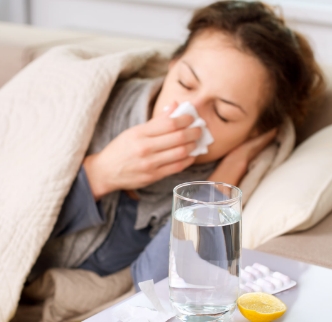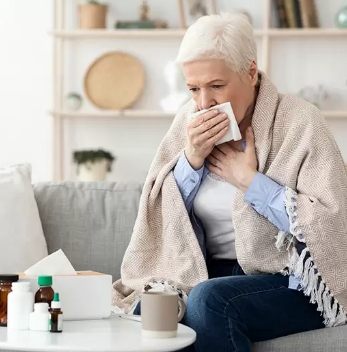Comprehensive Guide to Acupressure Points for Relieving Cough and Phlegm
Cough and phlegm are common symptoms that can threaten respiratory health. Did you know that you can alleviate these symptoms through acupressure massage without taking medication?
Our bodies have specific pressure points that can improve bronchial function and help expel phlegm. Learning the correct stimulation techniques for these acupoints can be useful in managing various respiratory issues such as colds, asthma, and chronic cough.

Key Acupoints for Respiratory Health
1. Tiantu (Celestial Chimney)
Located at the base of the throat, about 2cm below the collarbone towards the center of the chest, this point is known to be particularly effective in relieving the sensation of phlegm stuck in the throat. Use your index and middle fingers to apply gentle pressure for 3 seconds, then slowly release. Repeat this action 5 times to reduce coughing reflexes.
2. Taiyuan (Supreme Abyss)
This point is situated on the inner wrist, about 2cm from the wrist crease towards the thumb. It’s known to reduce inflammation in the bronchial mucosa and is recommended for dry cough sufferers. Massage this area in circular motions with your thumb for 2 minutes to also alleviate chest discomfort.
3. Hegu (Joining Valley)
Located in the webbing between the thumb and index finger on the back of the hand, this point is excellent for boosting immunity and regulating body temperature, making it effective for cough symptoms due to colds. Apply strong pressure with the opposite thumb for 5 seconds, followed by a 3-second rest. Repeat this rhythm 10 times.
Practical Tips for Effective Self-Massage
When performing acupressure, maintain room temperature between 71-75°F (22-24°C) and ensure your hands are warm. The most suitable times are immediately after waking up and 30 minutes before bedtime. Use the knuckle area of your fingers rather than the fingertips to apply consistent pressure.
Massage intensity should be maintained at a force of about 2-4 pounds, without causing pain. Excessive stimulation can lead to muscle spasms, so be cautious. For symptom relief, it’s important to perform these techniques consistently three times a day (morning, noon, and evening).
Precautions and Side Effects
Pregnant women and those with high blood pressure should avoid overstimulating the Hegu point. Always avoid areas with skin infections or wounds. If you experience headaches or dizziness after acupressure, stop immediately. If symptoms don’t improve after a week of self-care, consult an ENT specialist.
For chronic bronchitis patients, it’s beneficial to additionally massage the Feishu (Lung Transport) points located on either side of the spine. Find the area below the shoulder blades on your back and apply pressure with both hands simultaneously for 3 minutes to experience easier breathing.
Practical Respiratory Care Tips
In addition to acupressure, there are helpful habits to practice. Drinking at least 8 glasses of water daily helps thin mucus for easier expulsion. Ginger or quince tea can help reduce coughing reflexes, and maintaining indoor humidity at 50% is crucial for protecting mucous membranes.
When sleeping, elevate your pillow by about 6 inches (15cm) and lie on your side to keep airways open. Inhaling steam for 10 minutes every morning effectively removes accumulated phlegm. Combining these methods with acupressure techniques can significantly enhance respiratory health management.
Acupressure Techniques for Cough and Phlegm Relief
Let’s explore in detail the main acupoints effective for cough and phlegm relief and how to stimulate them.

Key Acupoints for Respiratory Health
1. Tiantu (CV22)
Location: At the base of the throat, in the center of the depression just above the breastbone.
Stimulation method:
– Locate the slight depression just above your breastbone.
– Gently press with your thumb for 3-5 seconds.
– Repeat this process 5-10 times.
2. Feishu (BL13)
Location: On the upper back, between the shoulder blades, about 1.5 inches from the spine.
Stimulation method:
– Find the point about 1.5 inches on either side of your spine, between the 2nd and 3rd thoracic vertebrae.
– Use your fingertips to massage in circular motions.
– Continue for 1-2 minutes.
3. Hegu (LI4)
Location: On the back of the hand, in the webbing between the thumb and index finger.
Stimulation method:
– Spread your thumb and index finger to locate the fleshy area.
– Press firmly with the opposite thumb.
– Hold for 10 seconds, release for 5 seconds, and repeat 5 times.
4. Yuji (LU10)
Location: On the inner wrist, between two tendons, about 1 inch below the base of the thumb.
Stimulation method:
– Find the depression between the two tendons on the inner wrist.
– Gently press with the opposite thumb.
– Massage in circular motions for 1-2 minutes.
Tips for Effective Acupoint Stimulation
To get the best results from acupoint stimulation, keep these points in mind:
1. Regular stimulation
– Perform 2-3 sessions daily, each lasting 5-10 minutes.
– The most effective times are right after waking up and before going to bed.
2. Appropriate pressure
– Apply pressure that’s firm but not painful.
– Avoid excessive force as it can be counterproductive.
3. Correct posture
– Sit or lie down comfortably.
– Keep your muscles relaxed.
4. Focus and breathing
– Practice deep, slow breathing during stimulation.
– Concentrate on the area being stimulated.
Precautions and Contraindications
While acupoint stimulation is generally safe, be cautious in these situations:
1. Pregnant women should avoid stimulating certain points (e.g., Hegu).
2. Avoid stimulating areas with skin conditions or wounds.
3. If you have serious underlying health conditions, consult a doctor before starting.
4. Stop immediately and seek professional advice if you experience persistent discomfort or pain after stimulation.
Lifestyle Improvements to Complement Acupoint Stimulation
Along with acupoint stimulation, these lifestyle changes can help manage cough and phlegm more effectively:
1. Adequate hydration
– Drink at least 8 glasses of water daily.
– Frequently sip warm herbal teas (e.g., ginger, jujube).
2. Indoor environment management
– Maintain optimal humidity (40-60%).
– Ensure regular ventilation.
3. Avoid smoking and secondhand smoke
– Smoking irritates the bronchi and increases phlegm production.
4. Regular exercise
– Light aerobic exercises can improve lung function.
– Avoid strenuous exercise when symptoms are severe.
5. Balanced diet
– Consume fruits and vegetables rich in Vitamin C.
– Avoid spicy and irritating foods.
Conclusion
Cough and phlegm can be uncomfortable and disruptive to daily life if persistent. However, with appropriate acupoint stimulation and lifestyle improvements, these symptoms can be effectively managed. Regular stimulation of the acupoints mentioned in this article, combined with maintaining healthy habits, can significantly improve respiratory health.
However, if symptoms are severe or persist for more than two weeks, it’s crucial to consult a healthcare professional for proper treatment. Remember, acupoint stimulation is a complementary method and should not replace professional medical advice.
Here’s to healthy breathing and an energetic daily life!